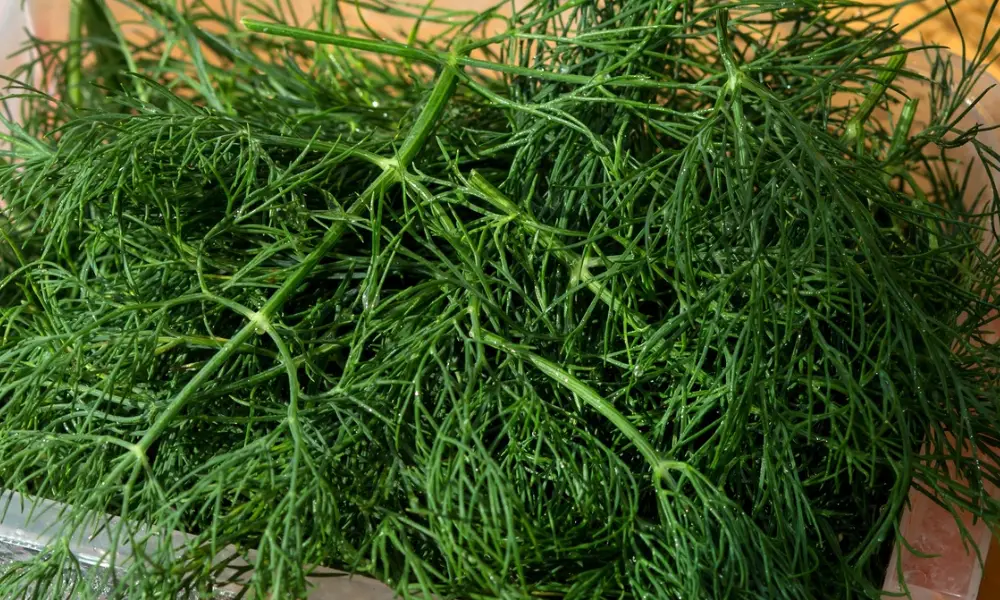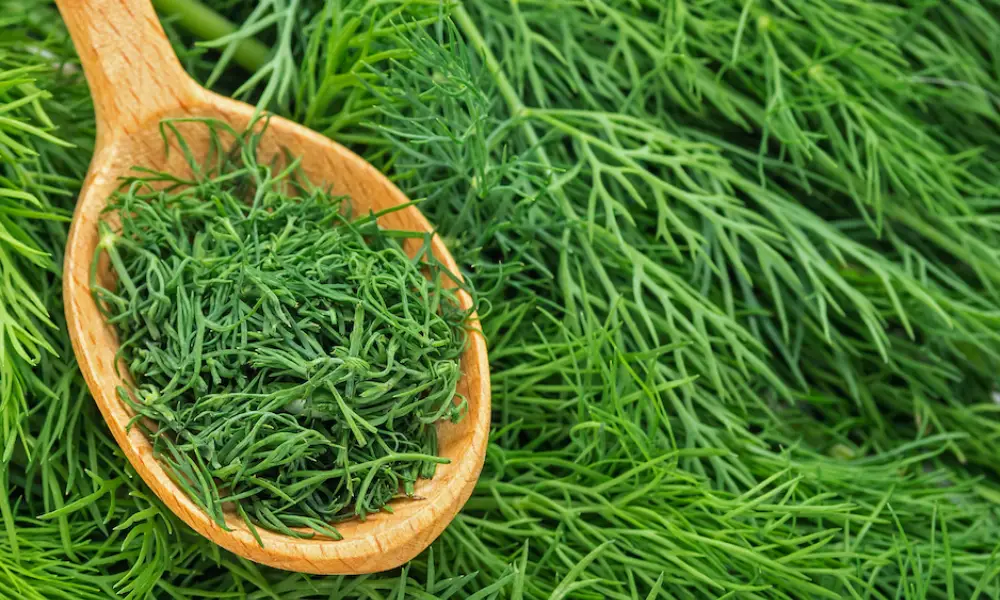Anethum graveolens, sometimes known as dill, belong to the Apiaceae family. Dill leaves are used as herbs to add flavor and perfume to food. Dill is a seasoning used to make curries, pickles, and soups. Dill leaves are 4 to 8 inches long and best utilized right away.
Dill oil, which is made from the leaves, is frequently used in the production of soap. The popular component dill is used in dips and as a garnish in the food of nations like Russia and Ukraine. Dill leaves are frequently combined with mashed or boiled potatoes, butter, and salads.

Popular herbs like dill are used in pickling and cooking. Although it has a limited shelf life, it can be kept for prolonged periods. Nevertheless, dampness can cause it to deteriorate. Keep it dry and avoid washing it unless required to prevent spoiling. The only exception is when dill is covered in dirt or insect infestations, which must be thoroughly cleaned and dried before being stored.
What is Dill?
The feathery green leaves of the dill plant (Anethum graveolens) are used to manufacture the dill weed herb, while the flat, oval fruits make dill seed spice. It’s a good idea to be aware of this annual celery-related herb’s propensity to replant itself and spread widely if you’re considering putting it in your garden. Dill seeds are used in pickles and other foods as a spice. Dill weed is delicate like chervil and goes especially nicely with eggs or salads.
How to Store Dill?
Fresh dill weed stems should be used within a day or two after being brought home and stored in the refrigerator loosely wrapped in plastic. Dill has a tendency to wilt and turn mushy quite fast after being plucked.
Dill can be preserved for a little while by placing a bunch in a jar or glass of water (much like flowers), covering the top with plastic, and storing the entire container in the refrigerator.
Dill freezes well but loses some of its flavors when dried. The leaves can be frozen successfully by processing them in a food processor or blender.
- After chopping the leaves into little pieces with a pulse, add just enough water to make a paste out of the chopped leaves. Paste should be spooned onto an ice cube tray, frozen, moved to a sealable plastic bag, and kept in the freezer. Then, add a dill ice cube if you want to give soups or stews a blast of fresh dill flavor.
- Fresh dill should be briefly misted with water before being wrapped loosely in a paper towel and placed in a zip-top plastic bag for storage.
- For up to a week, keep the dill in the vegetable drawer of your refrigerator. Fresh dill can also be frozen; after cleaning, the sprigs are spread out on a cookie sheet and frozen for a longer period.
- For the finest flavor, store the sprigs in the freezer for up to 6 months after freezing.
- Dill that has been frozen can be used in recipes right away. Dried dill and dill seeds should be kept in an airtight container in a cold, dark location for six months to a year.
1. Refrigerate Fresh Dill
The refrigerator is a good place to keep fresh dill weed for a few days. Dill should be cleaned in cold water, dried with a salad spinner to remove extra moisture, and then wrapped in damp paper towels. Put the wrapped stems and leaves in an airtight container or plastic bag. For up to two weeks, keep it in the crisper drawer.
2. Freeze Fresh Dill
Freezing dill is the greatest method for keeping it fresh-tasting for a long time. Start by properly washing the fronds and blossom heads of the dill sprigs before freezing them. Use a kitchen towel or a salad spinner to get rid of extra moisture. Put the dill springs in a freezer bag or upright in a glass jar. You can also freeze the dill that has been chopped.
The dill should be cleaned, dried, sliced, and divided into ice cube trays. Just enough water should be added to the pans to cover the dill. The ice cube trays should be put in the freezer and given time to freeze thoroughly. Remove the ice cubes from the freezer when they have frozen and place them in a plastic freezer bag. Use frozen dill within three to four months of freezing for the greatest results.
3. Dry Dill Weed
One of the most dependable techniques for long-term storage is drying herbs. Using a food dehydrator is the finest method for drying fresh herbs. If a dehydrator is unavailable, you can dry the dill by hanging it upside-down at ambient temperature for a few weeks. When the dill sprigs crumble to the touch, they are fully dry. Remove the leaves off the dried stalks with your hands and scatter them over a sizable dish. Dried dill leaves should be kept in a glass jar or airtight container. The shelf life of dried dill leaves is around twelve months when stored properly.
What does Dill Taste Like?
Dill has a grassy flavor with a hint of licorice-like anise. Be mindful that dill plants blossom or “bolt” whenever the weather gets hot. The leaves flavor is altered by bolting, becoming less fragrant and more bitter. Dill seed has a milder flavor than caraway.
Health Benefits of Dill
Insomnia
Herbal essential oils can have unusual and potent characteristics. They are thought to possess antiquated therapeutic qualities that might act as stimulants, sedatives, and hypnotics all at once. The dill’s essential oils are no different. Its essential oils contain flavonoids and vitamin B complex, which may stimulate the release of hormones and enzymes thought to have hypnotic and soothing effects, aiding in some people’s ability to fall asleep.
Bone Health
Dill contains calcium. Therefore it may help maintain healthy levels of calcium in the body. This may help prevent bone loss and decrease bone mineral density, two crucial factors that need to be prevented. Each year, millions of people are affected by osteoporosis. Calcium., along with other necessary minerals, is crucial for the healthy formation and growth of bones and the repair of broken bones.
Diabetes
Diabetes and the control of insulin levels have long been linked to dill. Studies have shown that it may help minimize the swings of serum lipids and insulin levels in corticosteroid-induced diabetes, even though research in this field is fairly restricted, particularly on human subjects. According to a study in Phytotherapy Research, giving dill extract to laboratory rats with corticosteroid-induced type 2 diabetes for 22 days may have caused a drop in their serum glucose and insulin levels.
Immunity
Dill has a long history of being linked to antibacterial properties. As a result, frequently eating this herb may help lower the risk of microbial illnesses in the body and infections that could lead to open wounds or minor skin injuries.
Hiccups
There are several causes of hiccups, but trapped gas and its repetitive upward passage through the food pipe are the main culprits. Certain allergies, hypersensitivity, hyperactivity, and nervous system dysfunction are the second cause. In certain circumstances, dill might be useful. Dill is supposed to help calm down hiccups brought on by allergies, hyperactivity, or nervous problems. As a carminative, it may aid in the expulsion of gases and also minimize gas production.
Diarrhea
Indigestion and microbial activity are the two main causes of diarrhea. Dill has excellent digestive characteristics. Thus, it might be particularly useful for indigestion. Second, the herb’s essential oils, which contain monoterpenes and flavonoids with germicidal or bactericidal properties, may also be helpful. They may lessen the symptoms of diarrhea by preventing microbial illnesses from attacking the body.
Joint Pain
Dill has a long history of being used as an anti-inflammatory plant, which suggests that it may lessen inflammation and the discomfort brought on by conditions like gout and rheumatoid arthritis. Dill has been utilized for this purpose since ancient times.
Where to Buy Dill?
You can find dried dill weed and seed in the grocery store’s spice aisle. Look for bunches of fresh dill in the produce or fresh herb department. A fresh dill plant will have unwilted leaves and freshly cut stems. Because dill fronds are light and sensitive, they easily wilt and get injured. When you go shopping and bring dill home, handle it gently.
Can I Freeze Dill?
Dill can be frozen, like most herbs, though doing so can cause a small change in texture. Cooks employ a range of techniques. The simplest method is to wash, dry, and then quickly freeze the dill (lay it on a paper towel in the freezer for an hour). When ready to use them, place the frozen fronds in an airtight bag and store them in the freezer. Dill can also be chopped and added to ice cube trays with a few drops of water. When you’re cooking, then, pop the cubes out.
What is a Suitable Dill Substitute in Recipes?
The recipes most frequently used alternatives to fresh dill are tarragon and fennel. Keep the dried dill on hand if you can’t get fresh dill. However, because the dried kind has a stronger flavor, you’ll use less of it.
Are Dill Weed and Dill Seed the Same Thing?
No. They both come from the same plant, but dill weed has a fresher flavor since it is made up of young, green fronds. Caraway-like dill seed offers a richer flavor. Dill seed is thought to have a more savory flavor.
What is the Purpose of Dill?
Dill is a plant used as a fragrance in soaps, cosmetics, and cooking spices. Dill seeds and other plant parts grew above ground have been used medicinally.
There are numerous ways to keep fresh dill at home, whether you grow it for harvest in your home herb garden or buy it there.
How to Freeze Dill?
Dill sprigs that have not been damaged by freezing can be used late into the winter and possibly spring. To get the most flavor from the dill when using it in canned foods, it is recommended to freeze both the leafy stems and the flower heads.
Give the dill fronds, and flower heads good water rinse to eliminate dust and insects. To get rid of most of the moisture, lightly shake the plant.
To keep the best shape, completely dry the dill by letting it hang upside-down. It can also be spread out on an absorbent material, like several layers of paper towels. The dill should only lose most of its moisture; avoid letting it become crispy dry.
Put the dried dill in a pail or airtight container and close the lid tightly. The dill will maintain its lovely shape in the freezer if your container enables it to sit erect.
Conclusion
A typical herb that can be dried at home is dill. Separate the dill fronds from the stem, then spread them out on a paper towel to dry. Dry till crisp, which should take two to three days. Dill leaves can be dried and kept in a dehydrator or an airtight container. Dill leaf drying is simple and quick, only taking a few minutes.

